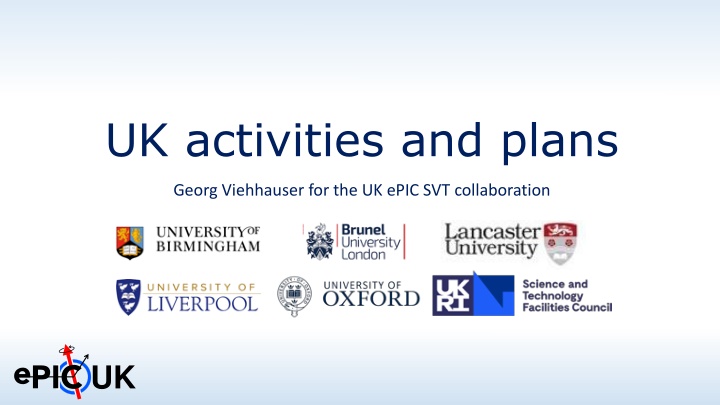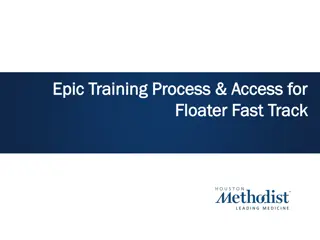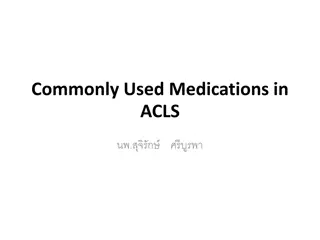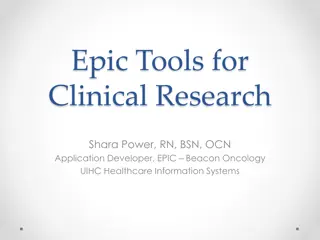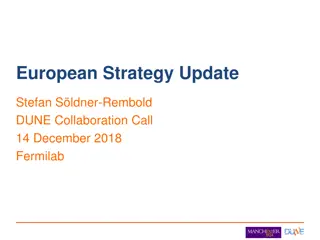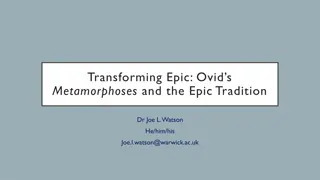UK ePIC SVT Collaboration Plans and Activities Update
Georg Viehhauser is leading the UK ePIC SVT collaboration with current funding from UKRI. Plans include sensor design, data transmission improvements, SVT layout study, and more. Future funding is sought for infrastructure and programme development starting in 2025.
Download Presentation

Please find below an Image/Link to download the presentation.
The content on the website is provided AS IS for your information and personal use only. It may not be sold, licensed, or shared on other websites without obtaining consent from the author.If you encounter any issues during the download, it is possible that the publisher has removed the file from their server.
You are allowed to download the files provided on this website for personal or commercial use, subject to the condition that they are used lawfully. All files are the property of their respective owners.
The content on the website is provided AS IS for your information and personal use only. It may not be sold, licensed, or shared on other websites without obtaining consent from the author.
E N D
Presentation Transcript
UK activities and plans Georg Viehhauser for the UK ePIC SVT collaboration UK
Funding Currently funded through UKRI Preliminary Infrastructure Fund Oct 21 Mar 24, 2.97M for MAPS, Timepix, and Polarimetry (29.2 FTE) This award is a Preliminary Activity or Scoping Project Future funding: EIC Full Phase Infrastructure Fund Starting in 25 for 7 y, for remaining R&D and construction 5 WPs (WP1 Silicon Tracker, WP2 Electron Tagger, WP3 Luminosity Monitor, WP4 Accelerator, WP5 Project Management) Has been prioritised by STFC SB/TAAB, Council and EB to go forward to Wave 3 of the UKRI Infrastructure Fund Have until June 30 to submit the final pro-forma application and costings for sign-off by EB before submission to Infrastructure Advisory Committee Bridging funds from 24 to start of Full Phase Infrastructure Fund Under negotiation with UKRI UK 2
What we are currently doing Sensor design Contributions to MLR and ER1 submissions High speed data transmission blocks, I2C on-chip transmission, library redesign for DFM Sensor characterisation Full characterisation of two APTS process splits at BHM and LIV, plots under approval by ITS DTPS setups to be received at RAL and DL in the next few weeks SVT layout Tiling study at BHM and initial work on CAD model at DL Powering Work on serial powering regulator, architecture, services Detector and physics simulations Parametrisation of momentum and vertex resolutions Studies of beam spot effect on the tracking performance Acceptance at large Barrel MPGD layer contribution to tracking New method developed for reconstruction of DIS kinematic variables UK 3
Programme to be funded Funding for 7 years, starting form 2025 The schedule is based on CD4A (transition into operation) in Apr 32 with detector delivery one year earlier in Apr 31 We requested 153 FTEs for 7 years (70% of cost of UK project) 25 FTE academics, 30 FTE PDRAs, 56 FTE engineers and 42 FTE techs For silicon submissions we costed A contribution of 37% to the mask/NRE costs of the EIC LAS V2 and EIC LAS production A contribution of 37% to production of the EIC LAS V2 wafers Entire production of wafers for the sagitta layers We assumed mask/NRE at 10 M , wafers at 10 k each, and a yield factor 2 Also consumables, equipment and travel to support the proposed programme UK 4
What we would like to do If compatible with preferences of the rest of the SVT community, We would like to supply the complete barrel sagitta layers (SL) Sensors, local and global support structures, powering, and on-detector services (cooling, cables and/or bus tapes, etc.) Including QA and QC during design and construction, incl. final acceptance of complete package Tentative sharing of tasks Task during construction phase Institute Task during R&D phase Institute Sensor design RAL-TD Sensor QC/QA BHM, BRU Sensor characterisation BHM, BRU, DL-TD, LIV, LAN Module assembly & testing (QC/QA) BHM, BRU, RAL-PPD, LIV On-detector electrical services (i.e. FPC) DL-TD, OX On-detector electrical service production DL-TD, OX Powering BHM, OX, RAL-PPD Local support production OX, DL-TD Local supports incl. cooling (i.e. staves) OX, DL-TD Loading modules onto staves + system test DL-TD, RAL-PPD, BHM SW/FW DAQ (EIC LAS/system test) BRU, DL-TD, LAN, RAL-PPD Full layer(s) assembly + system test OX, RAL-PPD, BHM UK Tooling (module assembly, stave loading) BHM, RAL-PPD, OX Shipping to BNL OX, RAL-PPD Global support (mechanics) OX, DL-TD, LIV BHM Birmingham, BRU Brunel, DL Daresbury Lab, LAN- Lancaster, LIV Liverpool, OX Oxford, RAL Rutherford Appleton Lab
Contacts and next steps Contacts: Peter Jones (overall UK project) Laura Gonella, Iain Sedgwick, Georg Viehhauser (UK WP1, SVT) Planned next steps: F2F meeting of UK SVT groups on June 28th in Liverpool Develop set of requirements and specifications for SVT and specifically SL In close collaboration with international SVT collaboration UK 6
Further Material UK 7
ePIC Collaboration and UK leadership US Project Management Jones (Birmingham) Teodorescu (Brunel) Montgomery (Glasgow) Dainton (Lancaster) Chartier (Liverpool) Gwenlan (Oxford) Zachariou (York) Lemmon (STFC Daresbury) Sedgwick (STFC RAL) Interim Institutional Board EPIC Steering Committee Gonella (Birmingham) Jones (Birmingham) Sedgwick (STFC RAL) Silicon Consortium 9 Detector WGs 6 Physics WGs Simulation Production and QA Global/Integration Gwenlan (Oxford) Newman (Birmingham) Inclusive Tracking Far Forward Gonella (Birmingham) Semi-Inclusive Zachariou (York) Gardner (Glasgow) Calorimetry Far backward Exclusive, Diffraction and Tagging DAQ/Electronics/Readout Cherenkov PID Montgomery (Glasgow) Sokhan (Glasgow/Saclay) Jets and Heavy Flavour Computing and Software TOF PID (AC-LGADs) UK BSM and Precision EW 8
Effort sharing Task Effort (FTE) Sensor design 7 Sensor characterisation and testing 23 Flexible printed circuits, modules and DAQ (incl. powering) 50 Staves production, global mechanical support and integration 29 FTE for tooling and assembly (including installation and commissioning) 41 Performance studies 3 UK 9
WP1.1 Sensor Design MLR1 Designs from RAL (Q4 2020) ER1 Designs from RAL (Q4 2022) First submission in TPSCo 65 nms Scoped within CERN EP R&D WP1.2 Significant drive from ITS3 Contributions from several groups Functional blocks for high-speed data transmission Yonsei? DPTS? 10 m OPAMP? SF AC? IPHC? Transistor test? PLL dual mode 1 GHz/ 7 GHz PRBS Generator CML Receiver I2C block for on-chip data transmission 20 m SF PW? NIKHEF? 25 m SF? 20 m AMP? AC? 20 m SF? 20 m SF? PAD chip? Opamp AC? 10 m AMP? DESY? RAL? SF AC? AC? 10 m SF PW? 20 m AMP? 15 m SF? NIKHEF? AC? CPPM? AC? 10 m SF? 10 m AMP? SF AC? IPHC:? rolling? shutter? larger? matrices,? DESY:? pixel? test? structure? (using? charge? amplifier? with? Krummenacher? Plus, redesigned standard cells for DFM RAL: LDVS receiver and CML transmitter Buffers, AND gates, NAND gates, inverters, Filler cells, Flipflops Scope: Technology exploration and prototype circuit blocks for future sensors Large number of test structures; including Analogue and Digital Pixel Test Structures 10 EIC Detector R&D | Oversight Committee Meeting | 15 November 2022
WP1.1 Sensor Design ER2 Plans RAL is now part of the ITS3 ER2 designers team contributing New logic libraries Fast driver/receiver blocks On-chip regulation In parallel, RAL is working on the design of a Shunt-LDO regulator for the serial powering scheme specific to the ePIC detector Specifications captured Bandgap circuit design advanced Shunt-LDO schematics design started Technology choice under consideration 11 EIC Detector R&D | Oversight Committee Meeting | 15 November 2022
WP1.2 Sensor Characterisation MLR RAL IP Block New MLR test setup for RAL IP block: LVDS receiver and CML transmitter Chips bonded to carrier boards at Birmingham and Liverpool X-ray irradiations carried out at CERN up to 9900 krad at two dose rates (Sep 22) Tests performed at Daresbury before/after irradiation Chips survived irradiation up to target dose ~10 MRad (Full results in: 20221021- XrayIrradReportV1-rep-2021a05.pdf, e.g. plots in slide 13 if needed) RAL chip in new test system by DL/BHAM/LIV 12 EIC Detector R&D | Oversight Committee Meeting | 15 November 2022
WP1.2 Sensor Characterisation MLR - APTS / DPTS ER1 RAL IP block MLR contains Analogue Pixel Test Structures (APTS) and Digital Pixel Test Structures (DPTS) designed by ITS3 groups The ER1 sensor and test structures received from manufacturing in March. Setup for RAL blocks testing in preparation (RAL TD, DL) Birmingham and Liverpool fully integrated in the ITS3 WP3 group Full characterization of 2 out of 4 process splits with APTS, preparing plots for June approval session Contribution to APTS test beam data analysis DPTS setups for RAL and DL expected in June 13 EIC Detector R&D | Oversight Committee Meeting | 15 November 2022
WP1.3 Modules and System Tests ALICE ITS3 EPIC SVT Wafer-scale sensor: L = 280 mm Will use same 3 sensor formats Each layer composed of 2 sensors Each layer composed of 4 or 8 sensors L0 = 2 x (3 x 9 reticles) L1 = 2 x (4 x 9 reticles) L2 = 2 x (5 x 9 reticles) L0 = 4 x (3 x 9 reticles) L1 = 4 x (4 x 9 reticles) L2 = 8 x (5 x 9 reticles) Note: 5 mm gap for beam pipe bake out ALICE ITS3 16.5 L2 L0 = 4 x 56.5; R = 36 L1 = 4 x 75.5; R = 48 L2 = 8 X 94.0; R = 120 ePIC - SVT L1 18 24 30 L0 Same 3 sensor formats: L0 = 3 x 9 reticles L1 = 4 x 9 reticles L2 = 5 x 9 reticles 1 sensor per wafer 4 or 8 sensors per layer 300.0 280.0 30 270 31.75 1:2 Scale Dimensions are mm 18.85 36 30 48 10 Digital Periphery Digital Periphery 18.85 56.5 120 56.5 75.5 75.5 94.0 94.0 Units = mm 14 EIC Detector R&D | Oversight Committee Meeting | 15 November 2022
WP1.3 Modules and System Tests EPIC sagitta layers Units = mm 840 L4 h =0.88 540 L3 420 270 270 120 L2 48 L1 L0 36 L0, L1 and L2 lengths are single sensors that are 270 mm long (9 reticles) L3 length can be achieved using two sensors 270 mm long (9 reticles) L4 length can be achieved using four sensors 210 mm long (7 reticles) L3 50 staves L4 78 staves 2 sensors wide = 37.7 mm 2 sensors long = 540 mm (2 x 9 reticles) Mean radius = 268.4 mm Rf overlap = 3.5 mm ~ 10% 4 sensors per stave; 5 sensors per wafer Require 200 1x9 sensors (40 wafers) 2 sensors wide = 37.7 mm 4 sensors long = 840 mm (4 x 7 reticles) Mean radius = 418.5 mm Rf overlap = 3.5 mm ~ 10% 8 sensors per stave; 10 sensors per wafer Require 624 1x7 sensors (63 wafers) 15 EIC Detector R&D | Oversight Committee Meeting | 15 November 2022
WP1.3 Modules and System Tests Disk tiling strategy Disk 2 restricting sensor size - - - - 400 300 200 100 100 r_high = 389.3 mm 200 300 400 Investigate sensor formats needed 0 r_max = 430.0 mm - r_low = 45.4 mm r_min = 36.8 mm r_bp = 31.8 mm 400 T8: 44 (1 x 8) T7: 20 (1 x 7) T6: 12 (1 x 6) T4: 60 (1 x 4) T9: 8 (1 x 9) T5: 4 (1 x 5) LAS Two designs studied: Design #1 = vertical tiles/sensors Design #2 = herringbone pattern (alternating vertical and horizontal tiles) - 300 EIC-SVT Disk-2/3n Tile - 200 148 sensors 896 reticles Fewer, longer sensors T4 T9 - 100 0 100 No sensor overlap on same side of disk 200 Sensor variants are assumed to be 1 reticle width by up to 9 reticle lengths 300 400 - - - - - 250 200 150 100 100 150 200 250 50 50 - 0 250 - r_high = 190.1 mm r_max = 230.0 mm r_low = 45.4 mm r_min = 36.8 mm r_bp = 31.8 mm - - - - T6: 20 (1 x 6) T5: 12 (1 x 5) 400 300 200 100 100 r_high = 387.8 mm 200 300 400 T9: 0 (1 x 9) T8: 0 (1 x 8) T7: 0 (1 x 7) T4: 8 (1 x 4) T3: 4 (1 x 3) T2: 4 (1 x 2) T1: 4 (1 x 1) 200 - 0 LAS r_max = 430.0 mm - r_low = 45.4 mm r_min = 36.8 mm r_bp = 31.8 mm 400 T6: 104 (1 x 6) T5: 16 (1 x 5) T4: 20 (1 x 4) T3: 20 (1 x 3) T2: 16 (1 x 2) T1: 16 (1 x 1) 150 - LAS - 300 EIC-SVT Disk-1 Tile 100 EIC-SVT Disk-2/3n Tile - - 200 50 192 sensors 892 reticles More, shorter sensors T1 T6 - 100 0 50 0 100 150 200 250 100 200 300 400 16 EIC Detector R&D | Oversight Committee Meeting | 15 November 2022
WP1.3 Modules and System Tests Mechanical design Work has started on modifying ITS3 mechanical design for the vertex layers Need to address cable routing, cooling and compatibility with EPIC support cone 17 EIC Detector R&D | Oversight Committee Meeting | 15 November 2022
WP1.3 - Modules and System Tests Serial powering scheme chosen as baseline for the ePIC SVT Provides lowest material option Shunt-LDO placement on a dedicated powering chip outside the sensor Allows re-using of ITS3 sensor on-chip power distribution; Does not require modification of sensor periphery; Can be prototyped and fabricated in cheaper technology SP scheme drafted for sagitta layers Current flowing between sensors on each side of the stave Factor 4 current reduction for L4, factor 2 current reduction for L3 Iout Iin L4 serial powering scheme; top stave top view, bottom stave side view Number of sensor low voltage and bias cables estimated and provided to EIC project engineers for integration exercise 18 EIC Detector R&D | Oversight Committee Meeting | 15 November 2022
WP1.4 - Detector layout simulations Parametrised momentum and vertex resolutions with the latest ePIC tracker configuration 19 EIC Detector R&D | Oversight Committee Meeting | 15 November 2022
WP1.4 - Detector layout simulations Study of beam spot effect on the tracking performance Minimal degradation of momentum resolution in specific pseudorapidity intervals where particles traverse support material; no effect on the vertex resolution. Same trend at forward pseudorapidity 20 EIC Detector R&D | Oversight Committee Meeting | 15 November 2022
WP1.4 - Detector layout simulations Study of acceptance at large eta Realistic disk design implemented in simulation Higher x lower Q2 bins lose acceptance Acceptance > ~80% for all bins Q2>1GeV2 for 100% efficient disks 95% efficient disks Example of disk configuration in tiling study Disk implementation in simulation 100% efficient disks 21 EIC Detector R&D | Oversight Committee Meeting | 15 November 2022
WP1.4 - Detector layout simulations Study of barrel MPGD layer contribution to tracking Different combinations of active silicon, MPGD and Time of Flight (TOF) layers Momentum and vertex resolution fully defined by SVT, with small improvement by TOF layer; no recovery in performance with the MPGD layer active in case of failure of one silicon layer; barrel MPGD layer contribution in pattern recognition only 22 EIC Detector R&D | Oversight Committee Meeting | 15 November 2022
